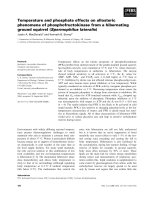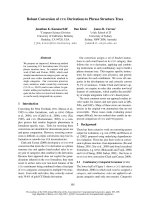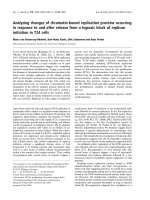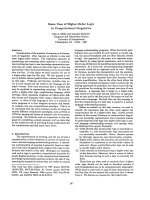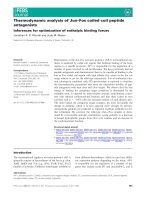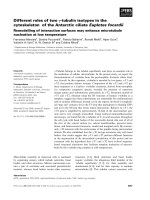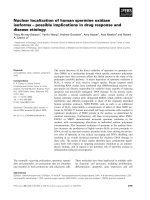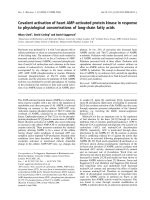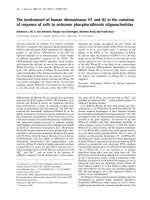Báo cáo khoa học: "Temperature response of photosynthesis of silver fir (Abies alba Mill.) seedlings." pdf
Bạn đang xem bản rút gọn của tài liệu. Xem và tải ngay bản đầy đủ của tài liệu tại đây (164.79 KB, 8 trang )
P. Robakowski et al.Temperature and photosynthesis in silver fir
Original article
Temperature response of photosynthesis of silver fir
(Abies alba Mill.) seedlings
Piotr Robakowski
a
, Pierre Montpied
b
and Erwin Dreyer
b
*
a
University of Agriculture in Poznan, Department of Forestry, ul. Wojska Polskiego 69, 60–625 Poznan, Poland
b
Unité Mixte de Recherches INRA-UHP “Écologie et Écophysiologie Forestières”, 54280 Champenoux, France
(Received 26 March 2001; accepted 12 November 2001)
Abstract – Temperature responses of photosynthesis were assessed in a shade tolerant tree species (silver fir, Abies alba Mill.) using leaf
gas exchange and chlorophyll a fluorescence measurements. Four-year-old seedlings grown in a greenhouse in N-E France were trans-
ferred into a climate chamber and kept during 24 hours at six temperature levels: 10, 18, 26, 32, 36 and 40
o
C. Response curves of net
CO
2
assimilation to substomatalCO
2
partial pressure wereobtained on small twigsbearing a single rowof needles under saturatingirra-
diance. Maximal carboxylation rate (V
cmax
) and maximal light driven electron flow (J
max
) were estimated by fitting Farquhar’s model to
the response curves at each temperature. “Dark” respiration (R
d
) was estimated at the end of each response curve by measuring gas ex-
change after 5 min darkness in the chamber. The temperature responses of the three parameters were fitted to a thermodynamic model.
Mean values at a reference temperature of 25
o
C were 37, 91 and 2.6 µmol m
–2
s
–1
for V
cmax
, J
max
and R
d
, respectively. Optimal tempera-
ture was higher for V
cmax
(36.6
o
C) than for J
max
(33.3
o
C), and no optimum was detected for R
d
. Such values are very close to those of
broadleaved tree species. The J
max
/V
cmax
ratio decreased with temperature. Activation energies were estimated at 56, 50 and 23 kJ mol
–1
for V
cmax
, J
max
and R
d
, respectively. The maximal quantum efficiency of PS II estimated from chlorophyll a fluorescence declined signifi-
cantly above 36
o
C. It nevertheless fully recovered after 1 day at 25
o
C even after 24 h heat stress at 40
o
C. Irreversible injuries to PS II
revealed by severe increases of ground fluorescence occurred at about 47
o
C. This critical temperature for PS II increased with the air
temperature imposed during the night preceding the measurements.
maximal carboxylation rate / maximal light driven electron flow / dark respiration / optimal temperature / thermostability
Résumé – Réponse thermique de la photosynthèse de jeunes semis de sapin (Abies alba Mill.). La réponse à la température de la
photosynthèse du sapin pectiné (Abies alba, conifère particulièrement tolérant à l’ombre) a été caractérisée en utilisant des mesures
d’échanges gazeux foliaires et de fluorescence de la chlorophylle a. Des semis de quatre ans élevés dans des conteneurs et en serre dans
le N-E dela France (INRA Nancy, Champenoux)ont été transportés dans unechambre climatisée et maintenusà 6 températures (10, 18,
26, 32, 36 et 40
o
C) pendant 24 h. Des courbes de réponse del’assimilation nette deCO
2
à la concentration intercellulaire de CO
2
ont été
établies sous éclairement saturant sur des rameaux de l’année portant une seule couche d’aiguilles. La vitesse maximale de carboxylation
(V
cmax
) et le flux maximal d’électrons (J
max
) ont été estimés pour chacune de ces courbes en ajustant les résultats expérimentaux au mo-
dèle de photosynthèse deFarquhar.La respiration des aiguilles (R
d
) a été estiméeaprèschaque courbe de réponse en mesurantleséchan-
ges gazeux après 5 min d’obscuritédanslachambre.Les valeurs moyennes des paramètres du modèle à 25
o
C ont été estimées à 37,91et
2,6 µmol m
–2
s
–1
pour V
cmax
, J
max
et R
d
, respectivement. L’optimum thermique était plus élevé pour V
cmax
(36,6
o
C) que pour J
max
(33,3
o
C), et aucun optimum n’a pu être estimé pour R
d
. L’augmentation de la température conduisait à une diminution du rapport
J
max
/V
cmax
. Les énergies d’activation ont été estimées à 56, 50 et 23 kJ mol
–1
pour V
cmax
, J
max
et R
d
, respectivement. Le rendement
Ann. For. Sci. 59 (2002) 163–170
163
© INRA, EDP Sciences, 2002
DOI: 10.1051/forest:2002003
* Correspondence and reprints
Tel. 03 83 39 40 41; Fax. 03 83 39 40 69; e-mail:
quantique maximal de la photochimie, estimé à l’aide de la fluorescence de la chlorophylle a, diminuait significativement au dessus de
36
o
C. Ce rendement quantique a néanmoins récupéré pleinement après une journée à 25
o
C, même après un stress thermique de 24 h à
40
o
C. Des dommages irréversibles au photosystème II ont été détectés sous la forme d’une augmentation de la fluorescence de base au
dessus de 47
o
C. Cette température critique pour le PS II a fortement augmenté avec la température imposée la nuit précédente.
température optimale / vitesse maximale de carboxylation / flux maximal d’électrons / respiration / stabilité thermique
Abbreviations:
C
i
–CO
2
substomatal concentration
F
0
– ground fluorescence
F
m
– maximal fluorescence
F
v
/F
m
– maximal quantum efficiency of PS II photochemistry
J
max
– maximal light driven electron flow
K
c
, K
o
– Michaelis-Menten constants of rubisco for CO
2
and O
2
,
respectively
PPFD – photosynthetic photon flux density
PS II – photosystem II
R
d
– (dark) respiration due to phosphorylative oxidations
RuBP – ribulose bisphosphate
T
c
– critical temperature for PS II
V
cmax
– maximal carboxylation rate
τ – specificity factor of Rubisco.
1. INTRODUCTION
Decline of silver fir (Abies alba Mill.) stands is an im-
portant problem inCentral European forests,and particu-
larly in the Sudete mountains of southern Poland. The
common sense states that the observed decline processes
are not relatedtoa single inducingfactor,but that they re-
flect a generally low resistance and low adaptability of
this species to adverse environmental factors, even
within its natural distribution area. Recent observations
of an abundant natural regeneration of this species in
Carpathian Mountains suggest that recent reductions of
air pollution in addition to local impact of global climate
changes may have improved the fitness of this species
(Korczyk, personal communication).
Temperature is a major environmental factor able to
modulate growth and survival ofsilver fir. One of theba-
sic processes governing productivity and growth that
may be severely affected by temperature is carbon gain,
i.e., photosynthesis and respiration. Optimal tempera-
tures for net CO
2
assimilation are known to vary among
species, and within species among provenances, display-
ing either a genetic variability related to the origin of the
provenances [5, 6] or a phenotypic variability due to ac-
climation to different growth temperatures [24, 27]. As
net assimilation results from a combination of several
processes such as CO
2
diffusion from atmosphere to
chloroplasts, carboxylation of RuBP, light driven elec-
tron flow,respiration, etc. thereis a need to documentthe
temperature response of these individual processes.
Leaf-level models of photosynthesis are useful in
quantifying the response of individual photosynthetic
processes to varying environmental conditions.
Farquhar’s [4] biochemically based model of leaf photo-
synthesis is often used to parameterise and compare
photosynthetic capacity among individuals and geno-
types. The keyparameters describing leafphotosynthesis
are the maximal rate of carboxylation (V
cmax
), the maxi-
mal light driven electron flow (J
max
) and the mitochon-
drial respiration due to phosphorylative oxidation (R
d
)
[4]. Some of the parameters used in the model, for exam-
ple the CO
2
/O
2
specificity of Rubisco, seem to be rela-
tively stable among a vast group of plants. Others may
considerably differ among species and such groups as di-
cots and monocots, hardwoods and conifers, and annuals
and perennials [29].
Many studies provided estimates of V
cmax
, J
max
, and R
d
and quantified the relationships between these parame-
ters and the total amount of leaf nitrogen per unit leaf
area for different tree species [14, 16, 20, 26]. However,
there are only a few data sets on the temperature depend-
ency of these parameters for trees, particularly for coni-
fers. Recent results showed the occurrence of some
degree of interspecific variability of the temperature re-
sponses of photosynthetic processes among broadleaved
tree species [2]. It was therefore of importance to com-
plete the already gathered data set by temperature re-
sponses of needle photosynthesis in silver fir. In this
work, we determined V
cmax
, J
max
, and R
d
and we studied
their temperature response in silver fir (Abies alba Mill.)
needles using Farquhar’s model [9].
High temperatures are known also to affect the
thermostability of photochemistry which may be studied
using chlorophyll a fluorescence [10]. The quantum
yield of photochemistry of dark adapted leaves (F
v
/F
m
)
usually decreases steeply at temperatures close to 38
o
C
[2, 3,10]. Groundfluorescence (F
0
) increasesat acritical
temperature [1]that is usuallymuch higher than the point
164 P. Robakowski et al.
of decreasing F
v
/F
m
, i.e., above 45
o
C [2]. The rise of
ground fluorescence is probably due to a separation of
light harvesting complexes from the PS II core complexes
or to a denaturation of PS II reaction centres [30]. The
PS II critical temperature increases (i.e., thermostability
of PS II increases) when leaves are pre-exposed to mod-
erately elevated temperatures [12]. We therefore esti-
mated the values of PS II critical temperature and
assessed the potential acclimation in this parameter re-
sulting from shorttermacclimation to high temperatures.
2. MATERIALS AND METHODS
2.1. Model
The temperature dependence of the parameters (P
(T)
)
of plant photosynthetic capacity can be described by an
Arrhenius type exponential function [17, 23]. Tempera-
ture dependence of the specificity factor of rubisco (τ )
and of the affinity for CO
2
and O
2
(K
c
and K
o
and R
d
) are
modelled with the following increasing function:
PP
TT
H
RT
T
T
() ( )
–
=×
×
×
ref
a
ref
ref
e
∆
1
(1)
where
P
()T
ref
is the parametervalueat a referencetempera-
ture T
ref
(298.16 K), H
a
(J mol
–1
) is the activation en-
ergy, R (8.3143 J K
–1
mol
–1
) is the gas constant, and T (K)
is the leaf temperature.
The temperature dependence of V
cmax
and J
max
is usu-
ally expressed with a model including an optimum [17,
28] as:
P
P
T
T
H
RT
T
T
ST H
RT
()
()
–
–
=
×
×
×
×
×
×
ref
ref
ref
d
e
+e
+e
a
∆
∆∆
∆
1
1
1
ST H
RT
×
×
ref d
ref
–∆
(2)
where
P
T()
ref
is the potential value that the parameter
would have at the temperature T
ref
in the absence of high
temperature inhibition , ∆S (J K
–1
mol
–1
) is an entropy
term, ∆H
d
(J mol
–1
) is thedeactivationenergy of thegiven
parameter.
The optimal temperature is derived from this function
as:
T
H
R
H
HH
S
opt
d
a
a
d
=
×
–
ln
–
–
–
∆
∆
∆∆
∆
(3)
The model primary data (K
c
, K
0
and τ) were taken
from Jordan and Ogren [13] and Von Caemmerer et al.
[25]. Apparent quantum yield of electron flow was set at
0.24 [9]. The equations and statistical methods put to-
gether by Dreyer et al. [2] were used to describe the tem-
perature dependence of the photosynthetic parameters
and to compute values of optimal temperature.
2.2. Plant material
Seedlings of silver fir were grown from seeds col-
lected from a selected tree in Midzygórze Forest Inspec-
torate (50
o
15’ N, 16
o
45’ E) in the Polish Sudety
Mountains. The mother tree was at 620 m a.s.l., in south-
ern exposure. Mean annual temperature at this site is
5.6 ºC, mean temperature of the coldest month (January)
–4.3 ºC, mean temperature of the hottest month (July)
+ 15.1 ºC. Mean annual precipitationwas estimated tobe
about 1030 mm.
The seedlings were grown in a nursery in Midzygórze
for the first three years. During April 1999, they were put
into polythene rolls with soil from the pots in which they
had been growing and transported in plastic bags to a
greenhouse at Champenoux (48
o
44’ N, 6
o
14’ E), near
Nancy, France. There they were transplanted into seven-
litres pots using a mixture of blond peat and sand
(2/5 v/v). They were fertilised at the beginning of
May with 10 g L
–1
slow release fertiliser Nutricote
100 13/13/13 N/P/K(supplemented with oligoelements).
Each seedling was watered to field capacity twice a day
using drip irrigation. In the greenhouse, the mean daily
temperature fluctuated between 19 and 32 ºC during the
whole year, the relative air humidity remained at about
64%, andthe meandaily PPFDvalues variedfrom 250to
650 µmol m
–2
s
–1
. The trees were grown for one year un-
der these conditions.
2.3. Temperature treatments
The potted seedlings were transferred during June
2000 to a climate chamber and acclimated during one
week underfollowing conditions:air temperature = 25 ºC,
relative humidity = 70% and PPFD = 250 µmol m
–2
s
–1
.
Thereafter, air temperature was changed in six 24 h steps
(10, 18, 26, 32, 36, 40 ºC) while RH and PPFD were kept
constant. The seedlings were exposed to each tempera-
ture for 24 hours prior to measurements.
Temperature and photosynthesis in silver fir 165
΄΅
΄΅
΄
΅
΄
΅
2.4. Gas exchange measurements and model
parametrization
Gas exchangewas recordedon smalltwigs with a por-
table open gas exchange system LiCor 6400 (LiCor, Ne-
braska, USA) usinga6cm
2
chamber with a red-blue
illuminator. Silver fir needles grow on the twigs in two
layers: the upper layer was severed to avoid self-shading
among needles. A twig with one layer of needles was in-
troduced into the photosynthesis chamber. The microcli-
mate in the chamber was set at: leaf temperature close to
external, RH at 65–70% and PPFD was at the saturating
level of 1500µmol m
–2
s
–1
. Photosynthesis ofneedles was
induced during 25–30 minutes at ambient CO
2
(35 Pa)
prior to generation of A/C
i
curves. Afterwards the con-
centration of CO
2
was increased to 175 Pa and gradually
reduced in 13 steps to5 Pa. Eachstep comprised astabili-
sation (at least 4 min)and three recordsat 1-min intervals
of net assimilation rate (A), stomatal conductance to wa-
ter vapour (g
s
) and intercellular CO
2
mole fraction C
i
.
After the last step of each AC
i
curve, the CO
2
concentra-
tion was changed to 40 Pa, the light in leaf chamber was
shut down and the respiration due to oxidative
phosphorylation (“dark respiration” – R
d
) was measured
after 5 min. in the dark. The needles in the gas exchange
chamber were collected and their projected area was
computed with a Delta T Area Meter (Delta T,
Hoddesdon, United Kingdom). Measured projected area
was used to recompute all gas exchange parameters.
Values of V
cmax
(maximal carboxylation rate) and J
max
(maximal light driven electron flow) were estimated by
fitting the model of Farquhar [4] to the Rubisco limited
portion of the A/C
i
curves at lower C
i
(CO
2
substomatal
concentration) and to the RuBP (ribulose bisphosphate)
regeneration limited one at saturated level of C
i
, respec-
tively (for details on the procedure see [2, 15]).
2.5. Contribution of twigs to respiration
A separate experiment was conducted to estimate the
relative contributionof needles, twigs and buds to “dark”
respiration. R
d
was measured on a leafy twig with buds, a
leafless twig with buds, and without buds at a tissue tem-
perature of 25 ºC in five seedlings in the dark. Needles,
shoots andbuds were driedin the ovenand their dry mass
was used as a basis to express R
d
. The respiration of
needles was calculated subtracting R
d
of the leafless twig
with buds from that of the leafy twig with buds. Like-
wise, the R
d
of buds was estimated by subtracting R
d
of
the needles and of the leafless twig from the R
d
of the
leafy twig with buds. Specific respiration was computed
as R
d
/biomass.
2.6. Thermal stability of photochemistry
Chlorophyll a fluorescence (F
0
– ground fluores-
cence, F
m
– maximal fluorescence) and the maximal
quantum yield of PS II photochemistry (the ratio of vari-
able to maximal fluorescence F
v
/F
m
, [7]) were recorded
in needles of 5 silver fir seedlings prior to gas exchange
measurements at the different temperatures. Five mea-
surements were carried out per seedling at each tempera-
ture. The restoration of PS II function after exposure to
40
o
C was monitored during 3 days at 25
o
C. The plants
were dark adapted for 12 hours on each day prior to mea-
surements carried out with a portable modulated
fluorometer MiniPAM (Walz, Effeltrich, Germany).
Thermotolerance of needle photochemistry and its
ability to acclimateto increasing airtemperature were es-
timated using the critical temperature for PS II
photochemistry defined asthe “thermal breakpoint”–the
temperature at which F
0
exhibits an upward inflection [1,
18]. Needleswere collected from seedlings and put intoa
moist filter paper. They were kept for two hours in the
dark under ambient temperature (25
o
C) prior to mea-
surements and introduced into a temperature-controlled
aluminium body with the end of the fiberoptics of a
fluorometer (PAM 2000, Walz, Effelrich, Germany).
Ground fluorescence was induced with a red diode at a
low PPFD of 1 µmol m
–2
s
–1
. The temperature of needles
was gradually increased from 20 to 60 ºC at a rate of
1ºCmin
–1
, F
0
was continuously recorded with a chart re-
corder and thecritical temperature estimatedgraphically.
3. RESULTS
3.1. Temperature responses of needle
photosynthesis
The values of V
cmax
(maximal carboxylation rate) and
J
max
(maximal light driven electron flow) were estimated
by fitting the Farquhar’s model to the Rubisco limited
portion of the A/C
i
curves at low values of C
i
(CO
2
substomatal concentration) and to the RuBP (ribulose
bisphosphate) regeneration limited one at saturating
level of C
i
, respectively. Both phases of A/C
i
curves
were well marked at each temperature level, with clear
166 P. Robakowski et al.
transitions from thefirstto the second.Nodecrease of net
assimilation was recorded at over-saturating CO
2
, indi-
cating the absence of limitation due to triose phosphate
utilization (starch and sucrose production [9, 22]).
The temperature response functions normalised to
values at 25
o
C are displayed in figure 1a. Both V
cmax
and
J
max
displayed marked increases with temperature, fol-
lowed by visible decreases at 40 ºC. This enabled us to
estimate the optimal temperature (36.6 and 33.3 for V
cmax
and J
max,
respectively). The ratioJ
max
/V
cmax
decreased with
temperature from 2.9 at 10 ºC to 1.1 at 40 ºC (figure 1b).
The values of activation and deactivation energy as well
as of entropy factor obtained by adjusting an Arrhenius
function (Eq. (2)) on the temperature response of V
cmax
and J
max
are displayed in table I.
The measured values of shoot R
d
increased exponen-
tially with temperature, although with more scatter in the
data (figure 1c). Computed values of R
d
at 25
o
C and of
activation energy for R
d
are displayed in table I. This re-
sponse was a composite of needle, bud and twig respira-
tion. An estimate of the mean contribution of each of
these compartments to the overall CO
2
release by the
shoot is displayed in table II; around 33% of the CO
2
re-
leased in the measurement chamber originated from the
needles. The contribution of twigs and buds to measured
gas exchange was therefore not negligible, and the likely
estimate of needle respiration at 25
o
C was closer to
0.86 µmol m
–2
s
–1
. Interestingly, specific respiration of
twigs and budswaslarger than that ofneedles(table II).
Temperature and photosynthesis in silver fir 167
Figure 1. (a) Temperature responses of maximal rate of
carboxylation (V
cmax
) and of maximal light driven electron flow
(J
max
). V
cmax
and J
max
estimated at six different temperatures and
normalized to the mean value at 25 ºC in needles from five
4-year-old seedlings of Abies alba (n = 5). The values of V
cmax
and J
max
were estimated by fitting the response functions to
curves of net CO
2
assimilation rate (A) to substomatal CO
2
par-
tial pressure (C
i
) obtained at 6 different temperatures. (b) Tem-
perature response of the ratio J
max
/V
cmax
(actual values). (c)
Temperature response of “dark” respiration of needles and twigs
(mean ± SD, Arrhenius function adjusted to the data, see table I
for coefficients).
Table I. Means (± SE when it could be calculated) of the param-
eters describing temperature responses of needle photosynthetic
capacity in 4-year-old seedlings of silver fir (Abies alba Mill.).
V
cmax
– maximal rate of carboxylation, J
max
– maximal rate of
electron flow, R
d
– dark respiration, ∆H
a
– activation energy,
∆H
d
– deactivation energy, ∆S – entropy factor, T
opt
– optimal
temperature.
Parameters V
cmax
J
max
twig R
d
needle R
d
Value at 25
o
C
(µmol m
–2
s
–1
)
37.3 ± 3.4 91.1 ± 6.4 2.62 ± 0.3 0.86
T
opt
(
o
C) 36.6 ± 1.9 33.3 ± 1.4
∆H
a
(kJ Mol
–1
) 56.2 ± 8.4 50.3 ± 7.8 22.6 ± 3.3
∆H
d
(kJ Mol
–1
) 272 217
∆S (J K
–1
Mol
–1
) 867 697
3.2. Photochemical efficiency and thermostability
of PS II
Maximal quantum yield of PS II was 0.786 at 10 ºC,
and then increased with rising temperature to maximal
value of 0.83 at 26 ºC. Temperatures above 36
o
C re-
sulted in a decrease down to 0.71 at 40
o
C(figure 2). Fol-
lowing the 2 days at 36 and 40
o
C, the restoration of PS II
efficiency occurred readily after 24 hours at 25
o
C but
was not complete (0.809 vs. 0.827 before the thermal
treatment, p < 0.001; figure 3).
The critical temperature for PS II stability in silver fir
needles was close to 47
o
C in needles acclimated to
10
o
C. It increased steadily with acclimation temperature
imposed during 24 h before the measurements by more
than 4
o
C(figure 4).
168 P. Robakowski et al.
Table II. Mean values (± SD) of specific dark respiration (R
d
)of
needles, buds and bare shoot in one year old silver fir twigs, and
weighted contribution of each compartmentto total twigrespira-
tion (n = 5).
Organs R
d
±SD
(nmol g
–1
s
–1
)
Min – Max
(nmol g
–1
s
–1
)
Weighted contribution
to twig respiration
Needles 3.7 ± 1 2 – 5 0.33 ± 0.12
Buds 5.6 ± 2 4 – 8 0.23 ± 0.10
Twig 8.1 ± 2 6 – 11 0.44 ± 0.05
Total 17.4 ± 3 1.00
Figure 2. Temperature response of the maximal quantum effi-
ciency of PS II (F
v
/F
m
) of silver fir needles (mean ± SD; n = 5).
The seedlings weresuccessively acclimated during 24 hto 6 lev-
els of air temperature (10, 18, 26, 32, 36 and 40
o
C) and F
v
/F
m
measured after 12 h darkness. Statistically significant differ-
ences among mean values were marked with different letters ac-
cording to Tukey’s a posteriori test with global α = 0.05.
Figure 3. Recovery time course of maximal quantum efficiency
of PS II (F
v
/F
m,
mean ± SD, n = 5) of silver fir needles after 24 h
at 40
o
C. Temperature was switched from 40 to 25
o
C as indi-
cated by the vertical bar. Statistically significant differences
among mean values weremarkedwith different letters according
to Tukey’s a posteriori test with global α = 0.05.
Figure 4. Impact of increasing acclimation temperature on the
critical temperature for PS IIphotochemistry of silver fir needles
(mean ± SD, n = 5). Critical temperature was estimated from the
break point in the ground level fluorescence of needles submitted
to a temperature increase of 1
o
C min
–1
. Acclimation time was
24 h for each temperature step.
4. DISCUSSION
Wullschleger [29] listed values of maximal
carboxylation rates (V
cmax
) and of light driven electron
flow (J
max
) among which only 10 had been measured on
conifer species. Mean values for conifers were
25 µmol m
–2
s
–1
(range from 6 to 46, for V
cmax
) and
40 µmol m
–2
s
–1
(17–121, for J
max
). The largerange of val-
ues wasa result of species characteristics and ofdifferent
experimental conditions (leaf temperature, light
microlimate). Our estimates of V
cmax
and J
max
at 25
o
C for
Abies alba Mill. (37 and 91 µmol m
–2
s
–1
, respectively)
were close to the highest among those reported for coni-
fers. They are close to those of 2-year needles of adult
trees from the fast growing Pinus pinaster [21], or of fer-
tilised seedlings from the same species [19]. Such high
values for a rather slow growing species may be ex-
plained by the high level of nutrients supplied in the pot-
ting medium as compared to natural conditions.
The temperature responses of V
cmax
and J
max
of silver
fir displayed features that are common to those obtained
with potted seedlings from a range of broadleaved spe-
cies (higher temperature optimum for V
cmax
than for J
max
,
decrease with increasing temperature of the ratio
J
max
/V
cmax
, higher activation energy (∆H
a
), deactivation
energy (∆H
d
) and entropy factor (∆S) for V
cmax
than for
J
max
) [2]. Nevertheless, optimal temperatures of V
cmax
(36.6 ºC) and J
max
(33.3 ºC) of silver fir were in the low-
est range of the values recorded in broadleaved species,
close to those of Acer pseudoplatanus and Fagus
sylvatica. Values of activation energy of the two parame-
ters V
cmax
and J
max
were also among the lowest ones.
Respiration of the leafy twigs was rather high on a
needle area basis; after correction for the contribution of
buds and stem, estimates yielded rather low values
(around 0.9µmol m
–2
s
–1
) whichis much lower than those
recorded in broadleaves. Similarly, the activation energy
was close to the lowest ones recorded on broadleaved
trees [2]. It is not known whether thermal sensitivities of
respiration of different organs like buds, stems and nee-
dles, differ significantly.
The maximal quantum yield of Abies alba PS II
(F
v
/F
m
) significantly decreased at temperatures above
36 ºC, very similarly to what was observed with many
other species (Cedrus atlantica, [3], Juglans regia,
Fagus sylvatica and Betula pendula [2]), but at lower
temperatures. This difference may presumably be ex-
plained by an adaptation to lower temperatures of Abies
alba, a species typically occurring at higher altitudes in
the mountains. The seedlings used in our experiment
originated from 620 m a.s.l.
The temperature at which a rise of F
0
occurs is related
to the critical temperature (T
c
) irreversibly injuring the
photosynthetic apparatus [1, 8]. The critical temperature
recorded in silver fir needles increased to a large extent
with the temperature experienced during the 24 h period
before measurements, aswas also noticedin a widerange
of other species [10, 11]. The absolute levels recorded in
our experiment were very close to those recorded on a
range of broadleaved species acclimated to 20
o
C [2].
As a conclusion, temperature responses of photosyn-
thesis components in silver fir were very similar to those
recorded with other tree species. Growth at high altitude
probably does notexert a selectivepressure on genotypes
towards lower temperature optima for photosynthetic
processes, or toparticular performance ofphotosynthesis
with respect to high temperatures. This lack of genotypic
effect on absolute temperature responses expressed at a
common microclimate does not exclude that species or
genotypes growing at high elevations may exhibit differ-
ent acclimation responses (in particular a potentially
lower optimum for light driven electron transfer [20]).
Further studies would be needed to document this point.
Acknowledgements: P.R. was supported by a post-
doctoral scholarship ofthe French Government.The help
of JeanMarie Gioriain growingthe trees is gratefully ac-
knowledged. This work was partly supported by the
French research consortium “GIP ECOFOR”.
REFERENCES
[1] Bilger H.W., Schreiber U., LangeO.L.,Determination of
leaf heat resistance: comparative investigation of chlorophyll
fluorescence changes and tissue necrosis methods, Oecologia 63
(1984) 256–262.
[2] Dreyer E., Le Roux X., Montpied P., Daudet F.A., Mas-
son F., Temperature response of leaf photosynthetic capacity in
seedlings from seven temperate tree species, Tree Physiol. 21
(2001) 223–232.
[3] Epron D., Effects of drought on photosynthesis and on
the thermotolerance of photosystem II in seedlings of cedar (Ce-
drus atlantica and C. libani), J. Exp.Bot.48(1997)1835–1841.
[4] FarquharG.D.,VonCaemmererS.,BerryJ.A.,Abioche-
mical model of photosynthetic CO
2
assimilation in leaves of C
3
species, Planta 149 (1980) 78–80.
[5] Ferrar P.J., Slatyer R.O., Vranjic J.A., Photosynthetic
temperature acclimation in Eucalyptus species from diverse
Temperature and photosynthesis in silver fir 169
habitats, and a comparison with Nerium oleander, Aust. J. Plant
Physiol. 16 (1989).
[6] Fryer J.H., Ledig F.T., Microevolution of the photosyn-
thetic temperature optimum in relation to the elevational com-
plex gradient, Can. J. Bot 50 (1972) 1231–1235.
[7] Genty B., Briantais J.M., Baker N.R., The relationship
between the quantum yield of photosynthetic electron transport
and quenching of chlorophyll fluorescence, Biochim. Biophys.
Acta 990 (1989) 87–92.
[8] Georgieva K., Yordanov I., Temperature dependence of
chlorophyll fluorescence parameters of pea seedlings, J. Plant
Physiol. 142 (1993) 151–155.
[9] Harley P.C., Tenhunen J.D., Modeling the photosynthe-
tic response of C3 leaves to environmental factors, in: Modeling
crop photosynthesis, from Biochemistry to Canopy, American
Society of Agronomy and Crop Science Society of America,
Madison, USA, 1991, pp. 17–39.
[10] Havaux M., Rapid photosynthetic adaptation to heat
stress triggered in potatoleaves by moderately elevated tempera-
tures, Plant Cell. Environ. 16 (1993) 461–467.
[11] Havaux M., Tardy F., Temperature-dependent ajuste-
ment of the thermal stability of photosystem II in vivo: possible
involvement of xanthophyll-cycle pigments, Planta 198 (1996)
324–333.
[12] Havaux M., Tardy F., Ravenel J., Chanu D., Parot P.,
Thylakoid membrane stability to heat stress studied by flash
spectroscopic measurement of the electochromic shift in intact
potato leaves: influence of the xanthophyll content, Plant Cell.
Environ. 19 (1996) 1359–1368.
[13] Jordan D.B., Ögren W.L., The CO
2
/O
2
specificity of ri-
bulose 1,5-bisphosphate carboxylase/opxygenase. Dependence
on ribulose bisphosphate concentration, pH and temperature,
Planta 161 (1984) 308–313.
[14] Le Roux X., Grand S., Daudet F.A.,DreyerE.,Le Dizes
S., Parametrization and testing of a biochemically based photo-
synthesis model for walnut (Juglans regia L.) mature trees and
seedlings, Tree Physiol. 19 (1999) 481–492.
[15] Le Roux X., Grand S., Dreyer E., Daudet F.A., Parame-
trization and testing of a biochemically based photosynthesis
model for walnut trees (Juglans regia) and seedlings, Tree Phy-
siol. 19 (1999) 481–492.
[16] Le Roux X., Walcroft A.S., Daudet F.A., Sinoquet H.,
Chaves M.M., Rodrigues A., Osorio L., Photosynthetic light ac-
climation in peach leaves: importance of changes in mass: area
ratio, nitrogen concentration,and leaf nitrogen partitioning, Tree
Physiol. 21 (2001) 377–386.
[17] LeuningR., Scaling to a common temperature improves
the correlation between the photosynthetic parameters J
max
and
V
cmax
, J. Exp. Bot. 48 (1997) 345–347.
[18] Logan B.A., Monson R.K., Thermotolerance of leaf
discs from four isoprene-emitting species is not enhanced by ex-
posure to exogenous isoprene, Plant Physiol. 120 (1999)
821–825.
[19] Loustau D., Ben Brahim M., Gaudillère J.P., Dreyer E.,
Photosynthetic response of two-year old Maritime Pine see-
dlings to Phosphorus nutrition, Tree Physiol. 19(1999)707–715.
[20] Niinemets U., Tenhunen J.D., A model separating leaf
structural and physiological effects on carbon gain along light
gradients for the shade tolerany species Acer saccharum, Plant
Cell. Environ. (1997) 845–866.
[21] Porté A., Loustau D., Variability of the photosynthetic
characteristics of mature needles within the crown of a 25-year-
old Pinus pinaster, Tree Physiol. 18 (1998) 223–232.
[22] Sharkey T.D., Stitt M., Heineke D., Gerhard R.,
Raschke T.K., Heldt H.W., Limitation of photosynthesis by car-
bon metabolism. O
2
-insensitive CO
2
uptake results from limita-
tion of triose phosphate utilization, Plant Physiol. 81 (1986)
1123–1129.
[23] Sharpe P.J.H., DeMichele D.W., Reaction kinetics of
poikilotherm development, J. Theor. Biol. 64 (1977) 649–670.
[24] TjoelkerM.G.,Oleksyn J., Reich P.B., Seedlings of five
boreal tree species differ in acclimation of net photosynthesis to
elevated CO
2
and temperature, Tree Physiol. 18 (1998) 715–726.
[25] Von Caemmerer S., Evans J.R., Hudson G.S., Andrews
T.J., The kinetics of ribulose-1,5-bisphosphatecarboxylase/oxy-
genase in vivo inferred from measurements of photosynthesis in
leaves of transgenic tobacco, Planta 195 (1994) 88–97.
[26] Walcroft A.S., Whitehead D., Silvester W.B., F.M. K.,
The response of photosynthetic model parameterstotemperature
and nitrogen concentration in Pinus radiata,Plant Cell. Environ.
20 (1997) 1338–1348.
[27] Wang K., Kellomaki S., Laitinen K., Acclimation of
photosynthetic parameters in Scots pine after three years expo-
sure to elevated temperature and CO
2
, Agric. For. Meteorol. 82
(1996) 195–217.
[28] WohlfarhtG.,BahnM.,HorakI.,TappeinerU.,Cernus-
ca A., A nitrogen sensitive model of leaf CO
2
and water vapour
gas exchange:application to 13 key species from differently ma-
naged mountain grassland ecosystems, Ecol. Model. 113 (1998)
179–199.
[29] Wullschleger S.D., Biochemical limitations to carbon
assimilation in C
3
plants– A retrospective analysis of the A/C
i
curves from 109 species, J. Exp. Bot. 44 (1993) 907–920.
[30] YamaneY.,KashinoY., Koike H., Satoh K., Increase in
the fluorescence Fo level and reversible inhibition ofPhotosytem
II reaction center by high temperature treatments in higher
plants, Photosynth. Res. 52 (1997) 57–64.
170 P. Robakowski et al.

